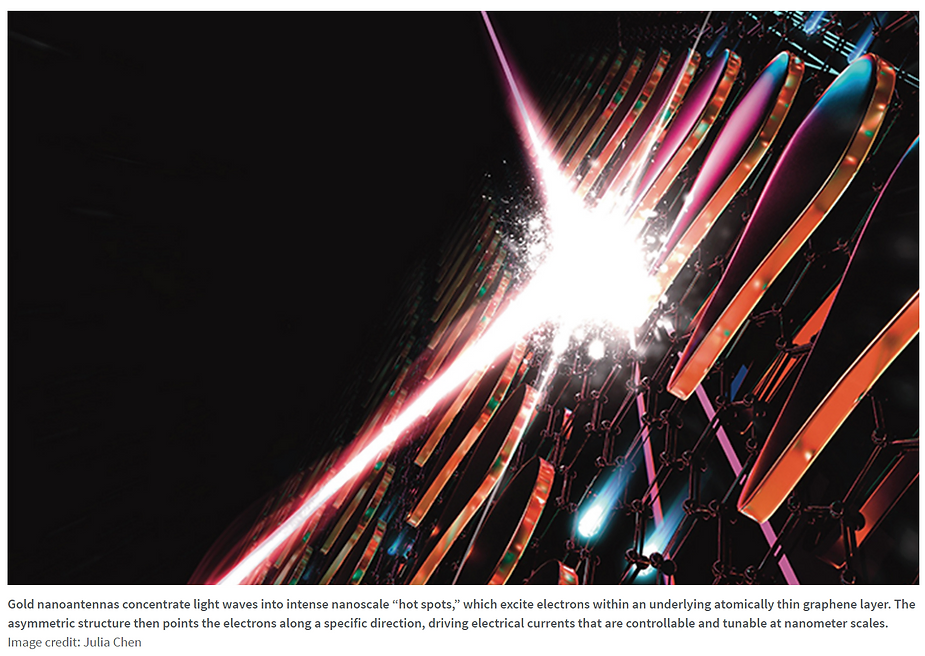Harnessing Light-Driven Graphene From Nanoscale Electrical Currents to Power Emerging Technologies
Updated: Feb 22
Abstract
Controlled charge flows are fundamental to many areas of science and technology, serving as carriers of energy and information, as probes of material properties and dynamics1 and as a means of revealing2,3 or even inducing4,5 broken symmetries. Emerging methods for light-based current control5,6,7,8,9,10,11,12,13,14,15,16 offer particularly promising routes beyond the speed and adaptability limitations of conventional voltage-driven systems.
However, optical generation and manipulation of currents at nanometer spatial scales remains a basic challenge and a crucial step towards scalable optoelectronic systems for microelectronics and information science. Here we introduce vectorial optoelectronic metasurfaces in which ultrafast light pulses induce local directional charge flows around symmetry-broken plasmonic nanostructures, with tunable responses and arbitrary patterning down to subdiffractive nanometre scales. Local symmetries and vectorial currents are revealed by polarization-dependent and wavelength-sensitive electrical readout and terahertz (THz) emission, whereas spatially tailored global currents are demonstrated in the direct generation of elusive broadband THz vector beams17.

We show that, in graphene, a detailed interplay between electrodynamic, thermodynamic and hydrodynamic degrees of freedom gives rise to rapidly evolving nanoscale driving forces and charge flows under the extremely spatially and temporally localized excitation. These results set the stage for versatile patterning and optical control over nanoscale currents in materials diagnostics, THz spectroscopies, nano magnetism and ultrafast information processing.
Graphene Technology Inside the Walls of the Vascular System


Nanoantenna’s Capture and Focus Light
As described in the article above just published in Nature, the research team designed and fabricated asymmetric, nano-sized gold structures on an atomically thin layer of graphene oxide. The gold structures are dubbed “nanoantenna’s” based on the way they capture and focus light waves, forming optical “hot spots” that excite the electrons within the graphene. Only the graphene electrons very near the hot spots are excited, with the rest of the graphene remaining much less excited.
The research team adopted a teardrop shape of gold nanoantenna’s, where the breaking of inversion symmetry defines a directionality along the structure. The hot spots are located only at the sharp tips of the nanoantenna’s, leading to a pathway on which the excited hot electrons flow with net directionality—a charge current, controllable and tunable at the nanometer scale by exciting different combinations of hot spots.
“These meta surfaces provide an easy way to control the amplitude, location and direction of hot spots and nanoscale charge current with a response speed faster than a picosecond,” Hou-Tong Chen, a scientist at CINT supervising the research.
2-Demensional Graphene Bio Chipping Inside the Body Fluids for the Purpose of Receiving & Transmitting Data From & To The Cloud – All Powered by Light-Driven Graphene For Nanoscale Electrical Currents

Copyright Hikari Omni Media & Dr. Robert O. Young 2024
Solutions to EMF Pollutions

Please support our work, reasearch and findings by purchasing “The pH Miracle Revised and Updated” & “Truth vs Deception – Liberty vs Tyranny – COVID – 19 Facts vs Fiction” and Science vs Scientism by donating at: www.givesendgo.com/research

Follow Dr Robert O Young on his scientific blog, twitter and telegram:Robert Young DSc, PhD, Naturopathic Practitioner – www.drrobertyoung.com/blogTwitter: @phmiraclelife
Telegram: https://t.me/DrRobertOYoungNews
To donate to the research of Dr. Robert O Young go to: www.givesendgo.com/research



